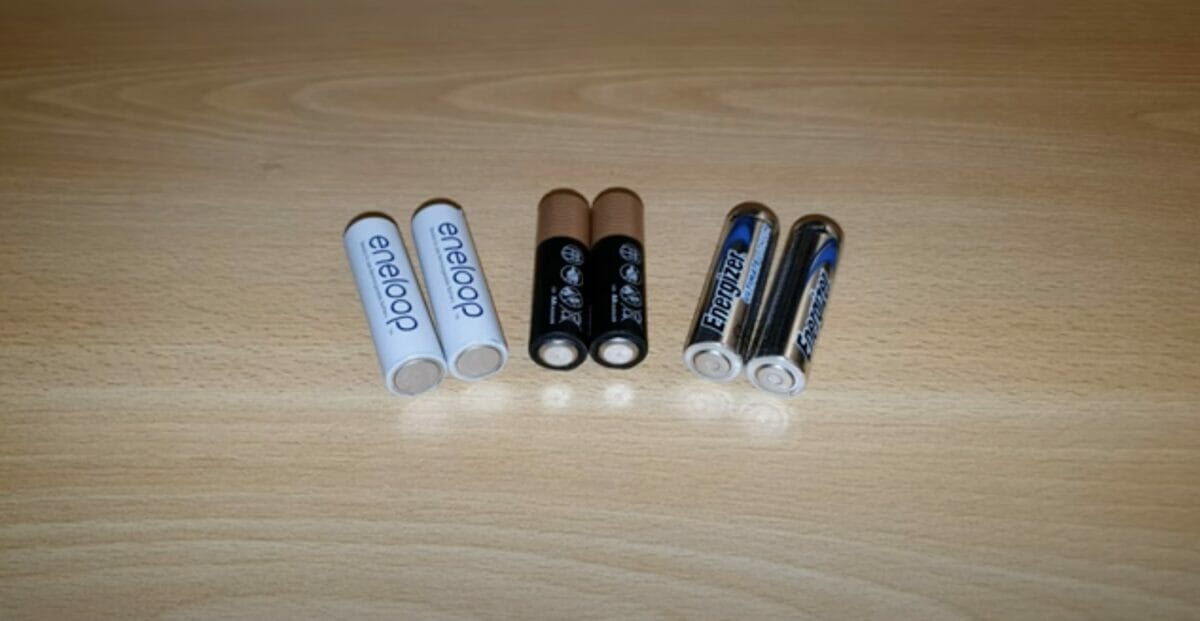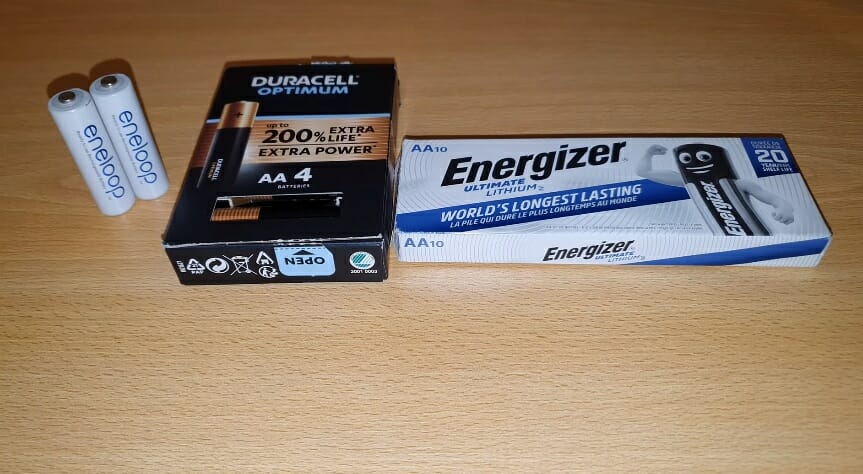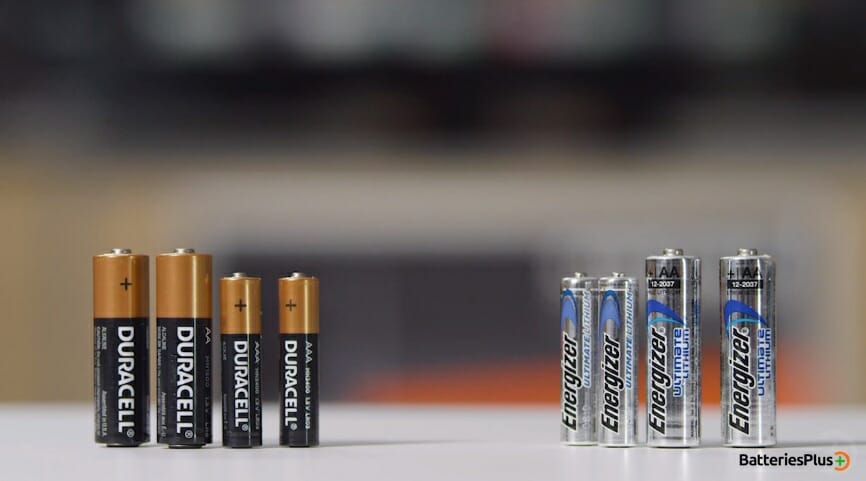What is the Difference Between Alkaline and Lithium Batteries?

Alkaline and Lithium are the two most common battery types and offer unique pros and cons, so which one should you choose for your devices?
There are a lot of key differences between Alkaline and Lithium batteries, but the six most important ones are:
- Chemistry and Components: Lithium batteries use Lithium-based components, while Alkaline batteries use Zinc or Manganese cells.
- Battery Capacity: Lithium batteries generally have a higher capacity.
- Resistance: Alkaline batteries have lower current resistance.
- Rechargeability: All Alkaline batteries are single-use, but some Lithium batteries are available in rechargeable types.
- Weight: Lithium batteries are around 33% lighter than Alkaline batteries.
- Usage: Alkaline batteries are typically used for everyday electronic devices, while Lithium batteries are used for rechargeable or delicate devices.
We’ll go into more detail on all the key differences between Alkaline and Lithium batteries below.
All the Differences Between Alkaline and Lithium Batteries

Table 1: Key Differences Between Alkaline and Lithium Batteries
| Characteristic | Alkaline Battery | Lithium Battery |
|---|---|---|
| Chemistry | Zinc/Manganese | Lithium-based |
| Capacity | Lower | Higher |
| Resistance | Lower | Higher |
| Rechargeability | Single-use | Some rechargeable models |
| Weight | Heavier | Lighter (33% less) |
| Typical Usage | Everyday electronic devices | Rechargeable/delicate devices |
1. Chemistry and Components
Lithium batteries are made using Lithium-based components. The two main types of components used for lithium batteries are divided into two:
- Ternary Lithium-Ion: Combines Lithium with one of three transition metal oxides of Nickel, Manganese, or Cobalt.
- Lithium Iron Phosphate (LiPO4): Typically composed of Lithium iron phosphate, but also includes those made using Lithium cobalt oxide (LiCoO22) and Lithium Nickel Manganese Cobalt Oxide (LiNiMnCoO2).
Alkaline batteries use Manganese or Zinc galvanic cells with an alkaline electrolyte. It’s usually composed of multiple interconnected battery cells inside a metallic casing.
An Alkaline battery typically uses a cathode made of Manganese dioxide (MnO2) and an anode made of Zinc (Zn). Potassium hydroxide acts as the battery’s electrolyte.
2. Battery Capacity
Battery capacity is the total energy extracted from a battery throughout its lifetime. It’s rated in terms of milliamp per hour (mAh).
A typical AAA alkaline battery has an 850 to 1,200 mAh capacity, while a Lithium battery of the same quality has a 1,200 mAh capacity. Moreover, Lithium batteries discharge less energy over time, causing them to have a longer shelf life and lifetime than Alkaline batteries.
3. Current Resistance
Resistance is the battery’s restriction on the current to prevent it from discharging. A lower resistance rate within a battery means reduced voltage and power.
Alkaline batteries have a lower resistance rate than Lithium batteries.
Lithium batteries provide more consistent voltage levels for long periods. It also has a flat discharge rate, meaning it doesn’t easily lose voltage while not in use. However, Alkaline batteries are preferred in devices that need much power to work thanks to their low resistance rate.
4. Rechargeability

Lithium batteries are available in rechargeable versions. They’re charged using the included charger pack or by using cycle chargers.
Alkaline batteries are intended to be single-use batteries. They’re thrown away and replaced once their entire energy capacity is used.
5. Weight
Lithium batteries tend to weigh less than Alkaline ones due to their chemistry and composition.
Lithium is among the lightest, commercially available metallic materials. It weighs around 33% less than its Alkaline counterpart, making it the battery of choice for electronic gadgets like drones, cameras, and phones.
6. Usage

Table 2: Battery Uses
| Type of Battery | Examples of Use |
|---|---|
| Alkaline | Remote Controllers, Smoke Detectors, Clocks, Toys, Small Lamps |
| Lithium | Phones, Tablets, Laptops, Digital Cameras, Handheld Power Tools, Headphones, Vapes |
Alkaline batteries are great options for an all-around battery. Their most common usage is for everyday electronic devices.
Some uses of Alkaline batteries are:
- Remote Controllers
- Smoke Detectors
- Clocks
- Toys
- Lighting Devices like Small Lamps
Lithium batteries are used for rechargeable devices and electronics with a delicate voltage tolerance.
Some uses of Lithium Batteries are:
- Phones, Tablets, and Laptops
- Digital Cameras
- Handheld Power Tools
- Headphones
- Vapes and Electric Cigarettes
7. Cost
Alkaline batteries are cheaper upfront than Lithium batteries.
The initial cost of buying Alkaline batteries is less expensive since they’re meant to be cheap, single-use batteries. However, when you look at the overall cost, rechargeable Lithium batteries are less expensive in the long run since you don’t have to keep buying them.
8. Battery Toxicity
All batteries are toxic, but the overall toxicity of the battery’s components differs greatly between Alkaline and Lithium batteries.
Alkaline batteries are moderately toxic.
Most countries don’t consider them as toxic or hazardous waste. They’re relatively safe batteries – provided you’re handling them correctly and don’t puncture or chew on them. One-time exposure to the chemicals inside an Alkaline battery is generally alright since they’re a cumulative neurotoxin and require high concentration to be considered toxic.
Lithium batteries are classified as hazardous materials that are highly toxic to the environment and human health.
Lithium batteries contain metals like Cobalt, Manganese, and Nickel, which are all toxic. The metals heat up when exposed to oxygen, resulting in gas and possibly fires and explosions. As such, you can’t just toss Lithium batteries in the trash. They need to be processed in the proper facilities to prevent leakage.
Despite the difference in toxicity concentration, get yourself checked out by a medical professional if exposed to leakage from both batteries.
References
Byju’s. https://byjus.com/chemistry/galvanic-cell/
United States Environmental Protection Agency. https://www.epa.gov/recycle/used-lithium-ion-batteries
Video References
HappyDude
vuaeco
Batteries Plus
